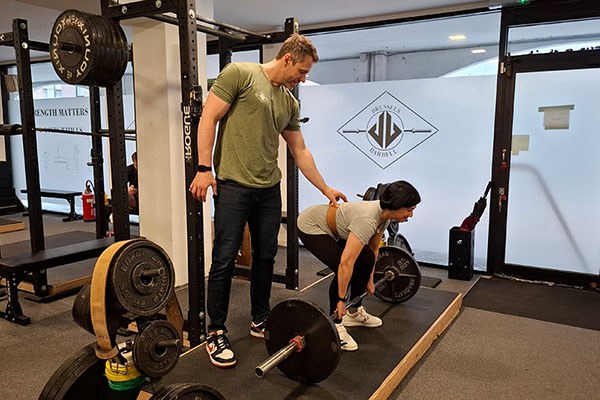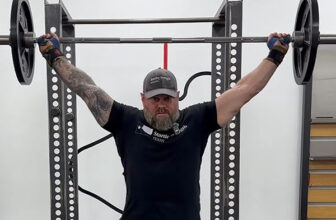
Walk into most commercial gyms and you’re likely to see a trainer
standing next to their client, often with their phone in hand,
shouting things like, “C’mon, 3 more!” or “You got this!” The
energy is contagious, and to someone just watching, it might seem
like that kind of encouragement is exactly what helps people get
stronger. But in reality, it’s not even close.
As someone who coaches
barbell training using the Starting Strength method at the only
affiliate gym in Europe, I can tell you there’s a massive
difference between mindless yelling and real coaching that leads to
consistent, long-term progress. Getting stronger takes more than
motivation or being yelled at. It requires solid programming, the
appropriate application of stress at the appropriate time,
consistency, and most importantly, executing these complex movement
patterns correctly. Progress isn’t built on enthusiasm alone, but
rather on mastering the details and getting better under the bar, all
the time.
Cueing plays an
important role in this process. A cue is not just a motivational
phrase or a catchy slogan. It is a specific, actionable reminder of a
movement detail that helps a lifter make an immediate improvement in
how they are executing a lift. As a coach, I’m not just standing
around shouting empty phrases I think my clients want to hear. I’m
watching closely, spotting deviations from correct technique when
they occur, and giving quick, actionable instructions to help the
lifter fix things on the next rep. It’s not hype and it’s not white
noise. It’s precision intervention.
It’s
also important to understand that cueing is not the time for teaching
new concepts. Cueing is about reinforcing what’s already been
taught during the teaching progression of each lift. My job during
the introductory Barbell Clinic at my gym is to lay the groundwork
first, teach the lifts correctly from scratch, and make sure the
lifter understands the whys and hows of each. When the bar is on
their back and we start squatting in earnest, then
and only then do cues come into play.
Once the bar is loaded and the work sets begin, the time for teaching
is over.
I like to think about
coaching the barbell lifts in the way my coaches interacted with us
during my professional basketball career. A coach on the sideline
isn’t yelling random stuff to fire players up, although it does
happen. Rather, they were in constant communication with us to help
us make the next play better. The same thing applies to the barbell.
Whether it’s a tactile, visual, or verbal cue, the goal is always
to the make the next rep – and thus the set – better.
Take the squat, for
example. If one of my lifters cuts a rep off short and misses depth,
I’m not going to shout, “C’mon, you’ve got this!”and I’m
sure as shit not going to say “Good!” Instead – and in real
time, right now – I need to identify the issue, figure out
why it happened, and how to fix it, by giving him a cue he can
process mid-set to make the next rep better. If we’re doing a set
of five, I don’t have the luxury of long explanations and there is
no way a lifter could process one anyway. I need to give him something quick and clear to react to, like “Knees out!”
to bring his attention to the issue and let his body respond.
The same goes for the
deadlift. If someone’s struggling to break the bar off the floor, a
typical commercial gym trainer might yell, “Pull harder!” But
mere yelling cannot and will not fix poor mechanics. As a coach, I’ll
make sure the bar is over mid-foot, the hips are in the right
position and aren’t dropping, and whether the lifter has set the
low-back properly. Then, I will cue accordingly. When those
mechanical things are dialed in, the lift becomes smoother, it feels
easier, the set gets completed, the lifter gets stronger, and we can
continue progressing. That’s my job and it’s what they’re paying
me for.
Unfortunately, many
trainers rely heavily on hype instead of actually coaching.
Meaningless cheering like “Let’s go!” or “No pain, no gain!”
might feel energizing, but it doesn’t do anything to improve a
lifter’s execution during a set. It’s white noise, and a way for
trainers to appear engaged without offering anything of actual value.
And that’s why so many people come to Brussels Barbell after months
(or even years) of “strength training” with personal trainers,
only to discover they were never actually taught how to use the
barbell. They’ve spent time doing random circuit workouts,
machine-based routines, or messing around with light weights and
elastic bands without ever having learned the most basic fundamentals
of strength. It’s unfortunate, but it’s common.
In barbell training,
hype alone simply will not cut it. You can’t yell someone into
better execution, and if they’re not moving well (your fault) or not
showing up consistently (their fault), progress will stall. No matter
how much you scream “Push harder!” at them, they will not get
measurably stronger. It’s reasonable to assume that he’s already
pulling hard on a heavy weight, but poor mechanics keeps the bar from
moving effectively. A coach who hypes people up without actually
teaching them anything of value isn’t just missing the point,
they’re doing a disservice to the client, and being dishonest about
the service they’re providing.
Sure, a little
motivation might help push through a tough set every now and then,
but if someone’s squatting high or is deadlifting with low hips and
the lumbar spine in flexion, you’re not helping them by ignoring
it. You’re just cheerleading, and you should be somewhere far away
from this person, not calling yourself a coach.
Consider the squat
again. It’s not just about dropping your hips in the hole and
“drahvin” your ass up. There’s bar placement, grip and grip
width, breathing, bracing, eye gaze, staying mid-foot, staying leaned
over and in the hips, among many others. We use specific cues to
address each of these aspects, whether before or during the set.
Every coach might phrase things differently, but the goal for all of
us is always the same: help the lifter focus on what matters in
that moment. And as they gain experience and confidence under the
bar, those cues start to click. They don’t need to think about
every little detail anymore, they just squat. When things start to go
sideways, as they always do, we’ll step in to remind them of what
they’ve already learned. We’ll cue them to fix the issue and get back
on track.
When trainers skip over
actually teaching anything, and go straight towards revving folks up,
they’re not doing their job, or quite frankly any job at all.
They’re missing the opportunity to help someone build a real,
lasting skill set. And in a lot of cases, they’re just taking money
from people who don’t know any better. Yes, there’s a time and
place for a little motivation, like before the last set of squats on
a grisly 5×5 volume Monday but if all you’re offering is a pep
talk, then you’re not coaching. You’re cheerleading. And that
kind of approach doesn’t just stall progress, it’s irresponsible,
and it can be dangerous for the lifter.
True progress comes
from building skills that someone can use long after they leave your
gym. It’s about applying the right stress, at the appropriate time,
with correct technique. It’s not just about trying hard – though
that obviously matters – it’s about doing things better, over and
over, until correct becomes second nature. Coaching helps make
that happen, cueing brings it all together, and when it’s done
right lifters don’t just move better during the session, they
continue to get stronger for years to come.
If I’m doing my job,
people won’t be dependent on me or Brussels Barbell forever. I want
every lifter at my gym to get good enough to eventually become their
own coach. I want them to understand the lifts, know how to fix small
issues on their own, and build the confidence that comes from
mastering hard physical tasks. Sure, they might stick around for the
community, the camaraderie, the support, and in some cases, the gym
dog, but they’ll have the skills to train independently, wherever
they go. That’s not something hype can give them.
Motivation can get you
into the gym, but it won’t teach you how to lift. It won’t fix a
shallow squat, the elbows dropping in the press, or an arm pull in
the power clean. If you’re constantly relying on someone else to
pump you up without teaching you how to actually lift correctly,
you’re missing out on one of the most valuable parts of strength
training: self-awareness – the constituent parts of the movement
that must be paid attention to in order to correctly execute the
movement. Cueing helps build that awareness, it happens gradually
over time, and it’s how a good coach helps lifters progress from
needing constant guidance to being able to train on their own
wherever they are.
So if you’re serious
about getting stronger, tune out the noise and ditch the hype. Coach what matters, when it matters. Get under the bar, and get to work.
Discuss in Forums
Credit : Source Post






